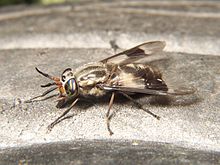- Deer fly
-
Deer fly 
Chrysops callidus Scientific classification Kingdom: Animalia Phylum: Arthropoda Subphylum: Uniramia Class: Insecta Order: Diptera Family: Tabanidae Subfamily: Chrysopsinae Tribe: Chrysopsini Genus: Chrysops
Meigen, 1803Species - C. altivagus Osten Sacken, 1886
- C. caecutiens (Linnaeus 1758)
- C. carbonarius Walker, 1848
- C. coloradensis Bigot, 1892
- C. excitans Walker, 1850
- C. facialis Townsend, 1897
- C. lateralis Wiedemann, 1828
- C. niger Macquart, 1838
- C. relictus Meigen, 1820
- C. sepulcralis (Fabricius, 1794)
- C. subcaecutiens Bellardi, 1859
- C. surdus Osten Sacken, 1877
- C. tidwelli Philip and Jones, 1962
- C. univittatus Macquart, 1855
- C. viduatus (Fabricius, 1794)
- C. vittatus Wiedemann, 1821
...many others
Deer flies (also known as yellow flies) are flies in the genus Chrysops of the family Tabanidae that can be pests to cattle, horses, and humans. A distinguishing characteristic of a deer fly is patterned gold or green eyes.[1]
Deer flies are a genus that belongs to the family commonly called horse-flies (Tabanidae). They are smaller than wasps, and they have coloured eyes and dark bands across their wings. While female deer flies feed on blood, males instead collect pollen. When feeding, females use knife-like mandibles and maxillae to make a cross-shaped incision and then lap up the blood. Their bite can be extremely painful, and allergic reaction from the saliva of the fly can result in further discomfort and health concerns. Pain and itch are the most common symptoms, but more significant allergic reactions can develop.[2]
They are often found in damp environments, such as wetlands or forests. They lay clusters of shiny black eggs on the leaves of small plants by water. The aquatic larvae feed on small insects and pupate in the mud at the edge of the water.[1][3] Adults are potential vectors of tularemia, anthrax and loa loa filariasis.
Predators of the deer fly (and other Tabanidae) include nest-building wasps and hornets, dragonflies, and some birds including the killdeer.
See also
References
- ^ a b Milne, Lorus and Margery (1980). The Audubon Society Field Guide to North American Insects and Spiders. New York: Alfred A. Knopf, Inc.. p. 651. ISBN 0-394-50763-0.
- ^ Bartlett, Kristen (1999). "Deer & Horse Flies". http://www.uri.edu/ce/factsheets/sheets/deerhorseflies.html. Retrieved 2008-10-09.
- ^ Stubbs, A. and Drake, M. (2001). British Soldierflies and Their Allies: A Field Guide to the Larger British Brachycera. British Entomological & Natural History Society. p. 512 pp. ISBN 1899935045.
External links
- Deer flies on the UF / IFAS Featured Creatures Web site
- Trolling deer fly trap
- Build personal and area protection traps
Categories:- Tabanidae
- Biting insects
Wikimedia Foundation. 2010.
